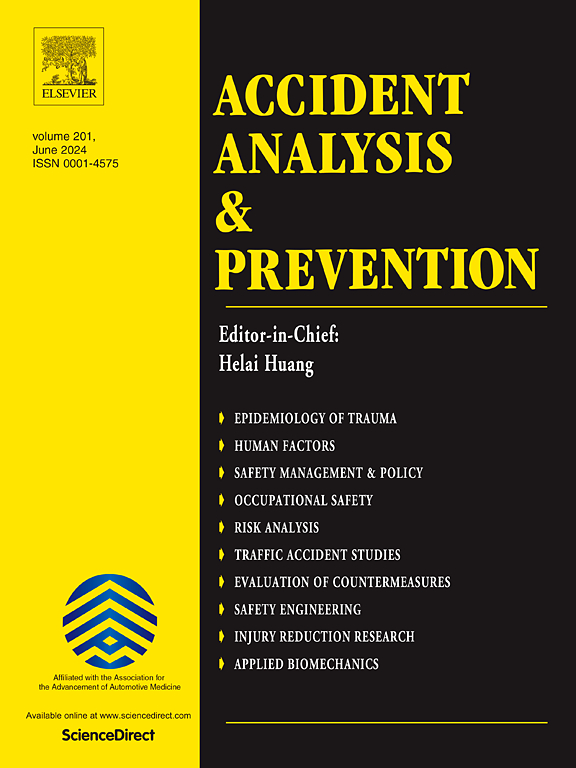A coordinated control framework of freeway continuous merging areas considering traffic risks and energy consumption
IF 5.7
1区 工程技术
Q1 ERGONOMICS
引用次数: 0
Abstract
Freeway continuous merging areas in a short distance exist continuous multiple ramps. In these areas, traffic flow and vehicle interactions are more complex, and traffic crashes and congestion are more frequent, which has been a major concern influencing traffic operation of freeways. Active traffic management (ATM) measures can improve traffic efficiency and reduce traffic risks in merging areas. Previous studies have focused on variable speed limit (VSL) control or ramp metering (RM) to address traffic problems in merging areas, whereas the problem of comprehensively ameliorating for traffic risks on mainlines and ramps by coordinating VSL and RM control strategies has rarely been explored. This study introduces a Bi-level Programming Model capable of coordinating controls of traffic risks (e.g., Crash Risk and Congestion Risk) in freeway continuous merging areas. The upper-level model aims to minimize the crash risk, the congestion risk, and vehicle energy consumption by VSL control. While the lower-level model focuses on the ramp control by minimizing the congestion risk and energy consumption of the ramp. Then an extended Cell Transmission Model (CTM) (it is based on VSL and RM control) is utilized to simulate the traffic flow of merging areas, based on which a traffic risk evaluation model and a Bi-level coordinated control model for the continuous merging areas are developed. The results demonstrate the constructed method outperforms other control strategies for improving the safety and efficiency of freeways. Specifically, the proposed control framework in the continuous merging areas of freeways reduces the average crash risk (ACR), average mainline congestion risk (AMCI), and average energy consumption (AEC) by 14.10%, 19.52%, and 8.86%, respectively. The research results could be potentially applied to active and coordinated traffic management of freeways.
考虑交通风险和能源消耗的高速公路连续合流区协调控制框架
高速公路连续合并区在短距离内存在连续的多匝道。在这些地区,交通流和车辆相互作用更加复杂,交通碰撞和拥堵更加频繁,这已经成为影响高速公路交通运行的主要问题。主动交通管理(ATM)措施可以提高合流区域的交通效率,降低交通风险。以往的研究主要集中在变速限制(VSL)控制或匝道计量(RM)控制来解决合并区域的交通问题,而通过协调变速限制和匝道计量控制策略来综合改善干线和匝道交通风险的研究很少。本文提出了一种双层规划模型,该模型能够协调控制高速公路连续合流区域的交通风险(如碰撞风险和拥堵风险)。上层模型的目标是通过VSL控制使碰撞风险、拥堵风险和车辆能耗最小化。而低层模型则侧重于匝道控制,通过最小化匝道的拥塞风险和能耗来实现。然后利用基于VSL和RM控制的扩展小区传输模型(CTM)对合并区域的交通流进行仿真,在此基础上建立了连续合并区域的交通风险评价模型和双层协调控制模型。结果表明,该方法在提高高速公路的安全性和效率方面优于其他控制策略。具体而言,在高速公路连续合流区域,所提出的控制框架使平均碰撞风险(ACR)、平均干线拥堵风险(AMCI)和平均能耗(AEC)分别降低14.10%、19.52%和8.86%。研究结果对高速公路的主动协调交通管理具有潜在的应用价值。
本文章由计算机程序翻译,如有差异,请以英文原文为准。
求助全文
约1分钟内获得全文
求助全文
来源期刊

Accident; analysis and prevention
Multiple-
CiteScore
11.90
自引率
16.90%
发文量
264
审稿时长
48 days
期刊介绍:
Accident Analysis & Prevention provides wide coverage of the general areas relating to accidental injury and damage, including the pre-injury and immediate post-injury phases. Published papers deal with medical, legal, economic, educational, behavioral, theoretical or empirical aspects of transportation accidents, as well as with accidents at other sites. Selected topics within the scope of the Journal may include: studies of human, environmental and vehicular factors influencing the occurrence, type and severity of accidents and injury; the design, implementation and evaluation of countermeasures; biomechanics of impact and human tolerance limits to injury; modelling and statistical analysis of accident data; policy, planning and decision-making in safety.
 求助内容:
求助内容: 应助结果提醒方式:
应助结果提醒方式:


